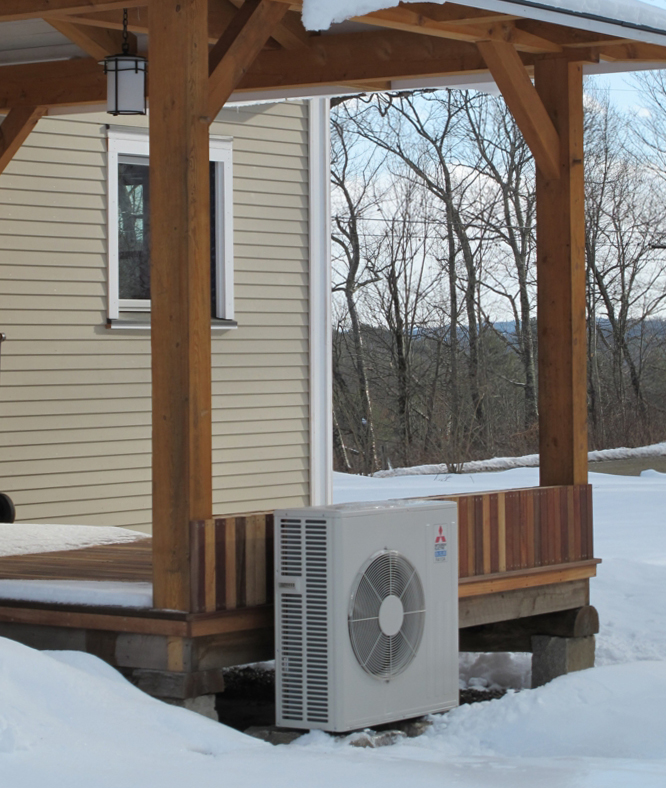
Air-source heat pumps are central to efforts to reduce building emissions. They use electricity to move heat out of the house in summer and into the house in winter. Over the course of a heating or cooling season, heat pumps can move three or more units of heat for every unit of electricity they consume. When combined with low-carbon electricity from wind and photovoltaics, they can deliver year-round comfort without fossil fuels.
Conventional heat pumps perform best under mild conditions. As outdoor temperatures drop, their efficiency—and the amount of heat they can deliver—falls off rapidly. Below a certain temperature, typically 30-40°F, they can no longer keep up with the house’s needs, and supplemental heat is required. The reliance on supplemental heat, particularly electric resistance, has given heat pumps a reputation as an expensive choice. Conventional heat pumps’ poor performance at lower temperatures has also limited their use in colder regions.
In the last two decades, a new generation of heat pumps suitable for colder climate zones has emerged. Many of these “cold-climate heat pumps” perform well at temperatures below 0°F. Their increased efficiency and the reduced need for supplemental heat make them a cost-effective alternative to electric baseboards, propane, and fuel oil. In some regions, they can achieve operating costs comparable to natural gas.
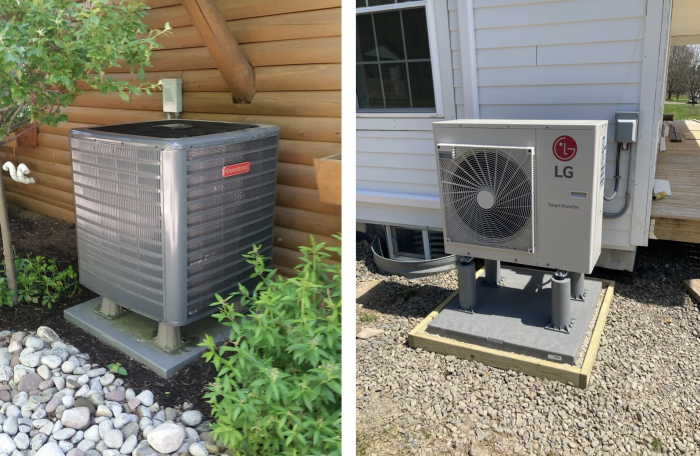
Unfortunately, public perception of heat pumps is influenced by the limitations of conventional equipment. To build confidence in the new technology, the Northeast Energy Efficiency Partnership (NEEP) and the EPA Energy Star program have established criteria for what constitutes a cold-climate heat pump. In this article, I’ll go over these criteria, then discuss features that allow cold-climate heat pumps to perform well at low temperatures.
Weekly Newsletter
Get building science and energy efficiency advice, plus special offers, in your inbox.

This article is only available to GBA Prime Members
Sign up for a free trial and get instant access to this article as well as GBA’s complete library of premium articles and construction details.
Start Free TrialAlready a member? Log in





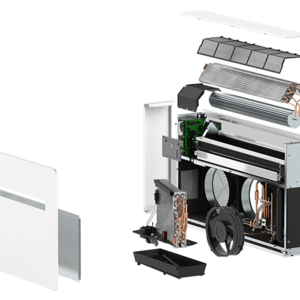
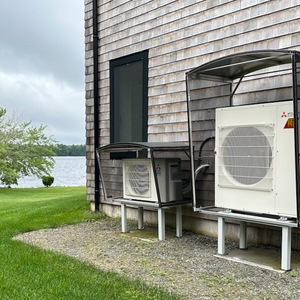
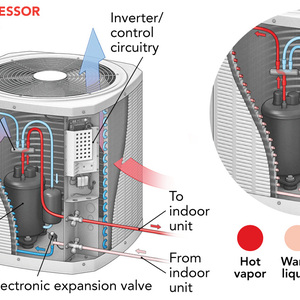







17 Comments
Jon, excellent article! I know where I'll be directing people (often professionals, unfortunately) who say that heat pumps don't work in cold climates.
I've heard a criticism of the upcoming refrigerant change that it's just mixing R410-A with a more-benign but less-effective refrigerant, and that the net result won't be greatly different from sticking with R410-A. I assume that's incorrect but I don't know enough to judge. What do you say?
Thanks, Michael. R-410A is a 50/50 mix of R-32 and R-125. R-32 has very good refrigerant properties and medium global warming potential but is slightly flammable on its own. R-125 has a much higher GWP but gives the mixture its "A1" flammability rating.
Unmixed R-32 is a leading candidate for R-410A replacement, but because of its flammability rating ("A2L"), it requires redesigned equipment and installation procedures. R-454B is another A2L refrigerant that is being considered. Both of these should have thermal performance at least as good as R-410A.
Neither R-32 or R-454B is perfect; their GWPs are 675 and 466. But they're both a big step in the right direction compared to R-410A (GWP = 2088), and shouldn't result in a big performance hit.
I go into A2L refrigerants more detail here:
https://www.greenbuildingadvisor.com/article/186618
There are some (or maybe just one?) heat pump water heaters that use CO2 as the refrigerant. I assume there is a reason why it isn't also being used in heat pumps for space heating/cooling. Why is that?
Nonflammable and a GWP of 1 are obvious benefits of CO2!
CO2 has a lot of great properties as a refrigerant, but there are a couple challenges for residential heat pump applications. One is that it operates at much higher pressures than HFC/HFO refrigerants, so it requires substantial redesign of piping and other system components. Another is that it won't condense above 88F at any pressure, which limits its use for cooling. But, given its environmental advantages, I expect we'll see it more in the future.
CO2 heat pumps can operate in the transcritical cycle above 88F, so the inability to condense is not strictly a limit. But the much higher pressures required certainly are more challenging.
This page has an example with a simple pressure-enthalpy diagram: https://www.ohio.edu/mechanical/thermo/property_tables/CO2/
A major challenge with using CO2 as a refrigerant for heat pumps is that they work above CO2’s critical point at ~88F. For a HP, COP equals the heat transferred out of the high-side heat exchanger divided by the electric input into to the compressor. With refrigerants that condense, the condensation process extracts a very large portion of the heat transferred. Since CO2 does not condense (gas cooler), the refrigerant needs to be cooled to a temperature closer to the cold-side temperature of the vapor-compression cycle prior to expansion to extract the same quantity of heat.
This enthalpy (x-axis) – pressure (y-axis) diagram shown from Stene (2007) illustrates this. In this case with a high-side temperature of 110C (230F), he found that reducing the temperature before expansion from 40C (104F) to 10C (50F) increased the COP by about 55%. Testing of the Sanden HPWH by Ecotope in 2013 found similar results: the COP plummeted as the water temperature in the bottom of the tank rose to higher temperatures.
Thus, the return-air temperature in the ducts effectively limits the efficiency of a CO2-based air-to-air HP, since the CO2 can only approach that temperature (analogous to the water temperature in the lower portion of a HPWH).
There are ways to productively extract more enthalpy from the refrigerant prior to expansion (e.g., suction-line heat exchangers, ejectors, work-expander device that helps power the compressor) and improve cycle efficiency, but they increase cycle complexity.
For air conditioning, the performance of CO2-based systems would also tend to be worse based on basic thermodynamics. On top of that, non-packaged units use a secondary fluid between the outdoor and indoor units instead of running refrigerant linesets (remember the ~100 atm operating pressures!), increasing system lift and decreasing efficiency. Prior testing has found that, for example, a work expander can eliminate much of the efficiency penalty, albeit while increasing cycle complexity and cost.
Could you please clarify the concept of "rated output", and how it relates to cold-weather performance? I've looked at a number of units in the NEEP database, and what I see is that often the rated output at 47 degrees is way under the maximum output at 47 degrees. If you take a 4-ton unit and call it a 2-ton unit, then of course you can claim no loss of output at 5 degrees. But that's a marketing solution, not a technological solution. Do the new standards address this? And maybe that's a valid approach, as long as the turn-down ratio at 47 deg is large enough so that it can run continuously and avoid short-cycling?
Hi Adam,
Mitsubishi Application Note 1013 (on mylinkdrive.com) gives a pretty good explanation of rated vs maximum capacity:
“Rated Capacity” is the system output capacity observed at standard AHRI rated testing
conditions (47°F, and 17°F outdoor for heating). AHRI testing, performed to AHRI-210/240,
requires the compressors to be run at a constant speed (60Hz) due to testing limitations. Any advantage gained by variable speed equipment is not exhibited in the test results..."
“Maximum Capacity” is the actual output capacity units will produce when trying to achieve set point condition (selected room temperature) from relative load condition (current room temperature). The greater the load requirement, the more the capacity increases until maximum capacity of the unit is reached. Maximum Capacity was equal to Rated Capacity before the introduction of inverter drive variable-speed compressor systems..."
I think you are correct, Rated Capacity understates the full capabilities of the equipment at 47F, which makes it easier to maintain this output as temperature drops. The Maximum Capacity at different temperatures (graphed on the NEEP site) is a better indicator of true performance.
Thanks for the detailed answer, and for the excellent article. It sounds to me like:
1) AHRI needs to update their testing methods. Anyone concerned about performance and long-term economics is going to be only looking at variable speed equipment, so not accounting for that in their current testing seems crazy.
2) In sizing a unit, what really matters is its output at local heating design temperature, and how LOW, not how high, it can modulate at 47 degrees, to avoid short cycling. The manufacturer's tonnage claim or rated output is a vague starting point, and without the NEEP graphs or detailed specs, you don't really have the necessary data to make the best choice.
Can a cold climate heat pump work as the primary heat source at 11,000 feet elevation with 10,500 heating degree days and a 99% design temp of -14?
J. Wolfe,
Yes, as long as the designer performs a heat loss calculation, and chooses equipment with a known heat output at -14 F. Such equipment exists.
Edit: I meant to reply to jwolfe1 and not Martin.
Here's a question about derating mini-splits for altitude: https://www.greenbuildingadvisor.com/question/how-much-are-mini-splits-really-affected-by-altitude
Post #4 has a link to slide from Fujitsu showing the derating factor: https://s3.amazonaws.com/greenbuildingadvisor.s3.tauntoncloud.com/app/uploads/2016/09/25014433/001%20Altitude%20Capacity%20Correction.pdf
At 11,000 ft you'll have to extrapolate a bit, but seems like 0.67 is a good estimate for that particular heat pump. You'd want to ask the manufacturer what the derating factor is for whatever unit you're considering, but this gives you some idea of how derating works.
For general purposes, how does a cold-climate heat pump compare with a ground-source unit. Is the expense of the wells justified?
Ground source heat pumps can achieve higher efficiencies, since they are extracting heat from the more temperate ground. Whether the expense is justified in a particular situation depends on several factors, including electricity prices, building loads, climate, vertical vs. horizontal loop field design, and eligibility for rebates/tax credits. Speaking very generally, I would say the expense is rarely justified for small, well-insulated homes.
Excellent article, Jon. Loved the deep dive. You seem to be very familiar with the Mitsubishi product line. Do you happen to know why only a few of the wall mount ductless units (like MSZ-FS) have btu/hr ratings at -5 F despite several ducted units (SVZ and PEAD) having guaranteed minimum operating temperatures of -13 F as well? In the next few years I’ll be embarking on a new construction project with design temperature of -9 F, and GBA advice tends to say best comfort will be achieved with ducted systems over ductless. Seems like it will be relevant to know btu/hr outputs at temperatures lower than 5 F. Thanks.
Are the efficiency of air source heat pumps affected by wind chill, which can make temperatures significantly lower? If they are, is this taken into account in their temperature ratings?
Also, is there a minimum tightness to a house recommended before switching to an air source heat pump? In Michigan, we're renovating an old 1930s house with 1950s and 1990s additions. We are working with a company to seal and insulate, which they estimate will improve the blower door test results from about 5,000 CFM@50 to about 2,500 CFM@50. The house is single-story and about 1,500 SF. We are looking to replace our old oil furnace with a ducted electric air source heat pump.
AH,
Wind chill does not "make temperatures lower." It cools warmer bodies by whisking away heat. Outdoor refrigerant in heating mode is colder than ambient air, so would not be adversely affected by this phenomenon. That said, I have heard that wind can still reduce performance due to moisture loading and the subsequent need for more defrosting. Hopefully someone more familiar with this issue can chime in.
Log in or become a member to post a comment.
Sign up Log in